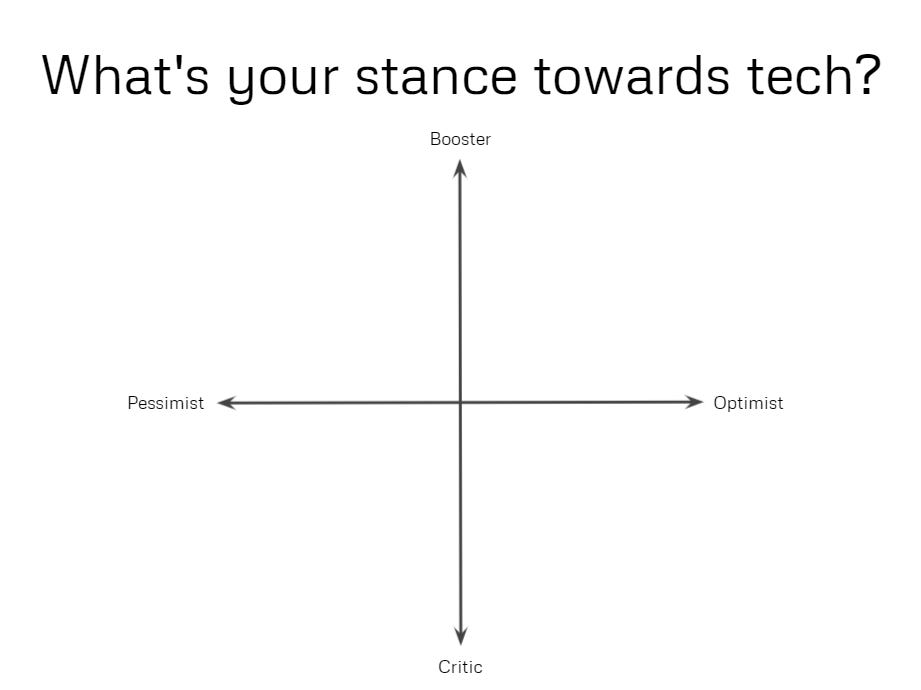What's your stance towards tech?
Critic or booster? Pessimist or optimist?
Automatter has a bit of a split personality -- and not just because it’s written by two independent humans with their own skills, experience, and opinions.
No, I’m talking about the range of content we’ve published over the past 9 months:
I wrote fun guides about investing process and automation like Personalize The Pass and Working Alone When Deciding As A Team; I also wrote “Productivity culture” is a dystopia machine and Mailstrom.
Halle wrote Automating Portfolio Company Onboarding and The year that everyone became a creator; she also wrote “The fetishized life without friction” and cast a skeptical eye on the latest DAO hype.
It might look like we’re wobbling between tech optimism and tech pessimism. But that’s not what’s happening. Our conviction remains strong: we believe in using automation and technology to live more fulfilling, productive lives in which our work doesn’t own us.
We’re walking the line between tech boosterism and tech criticism. Our inability to pick a shtick and stick to it places us in an unusual space in the tech conversation du jour. We’re in a classic 4-quadrant setup defined by intrinsic pessimism/optimism on one axis and outward criticism/boosterism on the other.
The Pessimistic Critic is relatively rare and easy to spot. They’ll usually announce themselves. Pessimistic Critics focus on the worst consequences and outcomes of technological change. While often exhausting, they’re worth listening to because they so often tap into real, deeply-rooted frustrations.
When you are personally powerful or otherwise responsible for changing the world, it’s hard to see in the moment whether it’s for better or for worse. Ignore them and abdicate your responsibility at your own peril.
The Optimistic Booster is also easy to spot -- and particularly prominent in 2021. When innovation capital is basically free and growth rates and valuations are through the roof, the market for positive stories is strong and self-reinforcing. We want to believe that what we’re seeing is real. Optimistic Boosters are happy to confirm that the future (and asset prices) are looking up and tell you inspiring stories of triumph.
The brand power of bringing guaranteed positivity to the party is as potent for Ted Lasso as it is for Packy McCormick.
And in case it isn’t clear, I mean that positively. Optimistic Boosterism tends to breed intrinsic passion for your craft, your subjects, and your fellow Optimists.
The Optimistic Critic may sound like a contradiction, but it isn’t. An Optimistic Critic understands both the promise and the power of tech. They relentlessly try to harness that power for good -- even when it contravenes the prevailing narratives set by the Boosters.
People hate listening to them because they hear criticism and equate it with pessimism. But if they were really pessimists, they wouldn’t risk blowing up their lives to make change. And they wouldn’t painstakingly imagine alternate timelines and futures.
The Optimistic Critic recognizes both the power of change and the power of choice. They want to remind you of your responsibilities in wielding those powers.
Pessimistic Boosters are the hardest to spot because they typically masquerade as Optimists. But unlike the Optimists, their vision of the future isn’t about change or choice. Pessimistic Boosters promote the darkest parts of the status quo with shiny, faux-inspirational platitudes. They promise change and then offer a front-row seat to the same over-financialized MLM bullshit that has destroyed so many lives.
And the worst part is they know they’re full of shit.
Funny enough, this matrix maps pretty cleanly to a chart from Zero to One by Peter Thiel, who may be the most successful Pessimistic Booster of all time.
The definite optimist has a concrete plan for the future and strongly believes in that future being better than today. The indefinite optimist is bullish on the future but lacks any design and plan for how to make such a future possible. The definite pessimist has a specific vision for the future but believes that future to be bleak. The indefinite pessimist has a bearish view on the future but no idea what to do about it.
Here’s the twist: Thiel’s definite optimist has more in common with the Optimistic Critic than the Optimistic Booster. Most individuals in the latter category are more attached to positivity than to any singular vision of the future. They are indefinite optimists. The Optimistic Critics are bringing definite, concrete plans and consistent values to the table.
The other side of the chart is flipped: Thiel’s indefinite pessimists map directly to the Pessimist Critics who are just steadfastly against progress and his definite pessimists are the grifters who are boosting the worst of what tech has to offer.
Indefinite pessimists can’t imagine good outcomes and definite optimists are realists verging on idealists. Those seem obvious enough. Boosterism, on the other hand, is often the path of least resistance. Indefinite optimists are naturally inclusive: They believe there are multiple paths to success and growth.

Definite pessimists? They see only one path to success. At scale, limiting yourself to one path is not the way of least resistance, so they need to give you a narrative arc to follow until you are fully bought in. Definite pessimists resemble cult leaders and their visions echo that.
For example, “crypto countries.” Or gathering people based on their “spiritual impulse to find the frontier, to be pioneers, and to build.” The definite pessimist draws on our shared history to tap into deep human needs, but pushes us to forget or ignore the dark parts of that history.
The indefinite pessimist believes we are doomed to repeat history (or make things worse) and despairs. The definite pessimist believes we are doomed to repeat history and wants their followers to be thrilled about it.
The optimist believes that change is possible. One small step that makes all the difference.










